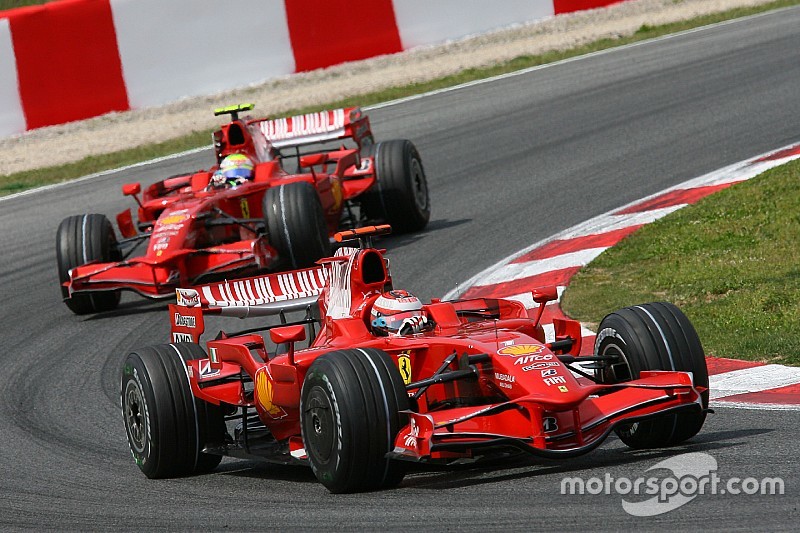mrluke wrote: ↑08 Nov 2017, 22:05
GPR-A wrote: ↑07 Nov 2017, 05:28
mrluke wrote: ↑06 Nov 2017, 22:06
Is there any
evidence that supports the view that lower wake helps car follow closer of that less wing downforce helps cars follow closer?
Im going to suggest that at Mexico it was much harder for cars to follow closely. Further due to the lower air density even having one of the longest straights in F1 and DRS it was very difficult for one car to get past another slower car.
I think that running very high drag would actually make overtaking easier as the slipstream would be a much higher benefit.
Link -> Lewis Hamilton says boosting downforce to lower lap times in 2017 is the 'worst idea'
Lewis Hamilton to SkySport, 27/11/15 wrote:"I know they're talking about giving us more aerodynamics, which for me is like the worst idea. It just shows that, for me, they don't really know what they're trying to solve.
"From a driver's point of view, we want more grip from the tyres; we want less wake coming from the car in front so therefore we can get closer.
This will help you gain some more understanding of the "Wake" issue.
https://www.f1technical.net/forum/viewtopic.php?t=22412
Highlighted the key word.
FWIW I am in agreement with Bhall from your link (as I was the last time this was discussed)
Quoting from Bhall:
http://i.imgur.com/AX7HeMc.jpg
There was a big change in Aero rules between 2008 and 2009 which greatly simplified the cars, removed a lot of the sensitive winglets and there was absolutely no change in the amount of overtaking in the season.
From this:
https://cdn-1.motorsport.com/static/img ... -ferra.jpg
to this:
https://www.f1fanatic.co.uk/wp-content/ ... _20091.jpg
Made absolutely no difference at all.
But sorry I am dragging this somewhat off topic.
Did you try and understand what could have been the reason, why the overtaking trend was such, through the years? Let me try and help.
The numbers of cars participated over the years.

This is the % AND NOT the actual number of overtakes. I will explain why this is accurate.

And if you see there, THERE WAS AN INCREASE in overtakes in 2009. Something more interesting here. I have taken qualifying performance from Malaysian GP in 2008 and in 2009 as a reference. As the track generally offered good overtaking opportunities, this is a good reference.
2008
 2009
2009

Observe the performance difference between the top 10 cars from 2008 to 2009. The field got bunched up! Which means, lower overtaking possibilities. But again, here is another interesting statistic. The DNFs in 2008 and in 2009.
More DNFs in 2008, compared to 2009. Had the 2008 cars managed to have the 2009 reliability, there was theoretically more overtakes possible. Contrary to that, if the field in 2009 was as spread as it was in 2008, theoretically, more overtakes were possible. Different factors balancing the act, but in different ways! But, if you look at the first picture, it shows that the % of overtakes increased 2009!
2008
 2009
2009

And compare the reliability situation to 1991. (Click to enlarge). 34 cars and disastrous reliability. If those cars would have had the 2011 type of reliability, the overtaking numbers would have gone out of the roof.

This is the qualifying performance difference between top 10 cars in 1991 USA GP. With such a large performance gap, there must have been great number of overtakes, but the balancing factor was bad reliability that never allowed cars to really be on track in races. If the cars of 1991 would have managed a reliability like that of 2016-17 Mercedes cars, Ayrton could have lapped the last 15 (of the 34) cars, atleast 15 times in the race. That is around 225 overtakes in one for race for one driver alone! Ayrton had lapped the 8th placed Gabriele Tarquini, 4 times.

So, the truth of the matter lies in the details of the situations. Factors like number of cars participated, performance difference between the cars and the reliability issues have all contributed to a skewed picture of overtaking over the years. The overtaking graph considers none of those factors as I don't think the intent was that either. It just shows number of overtakes, without going into any further details.
Simply looking at a trend graph says nothing. When a credible driver talks about his difficulties in overtaking, it has to be granted a level of authenticity.
Mods, please move this discussion to an appropriate thread. Thanks.










